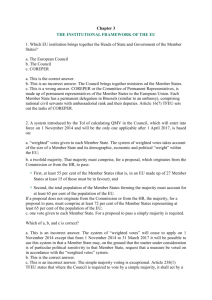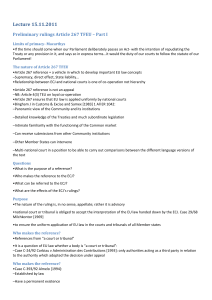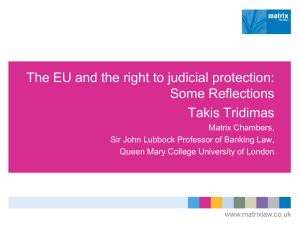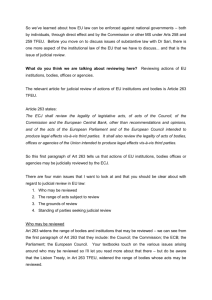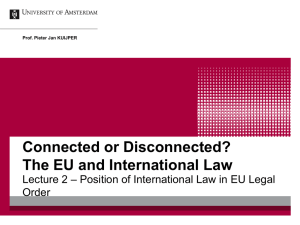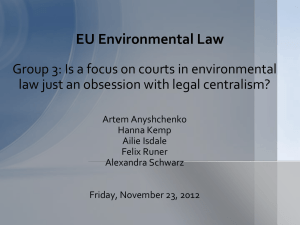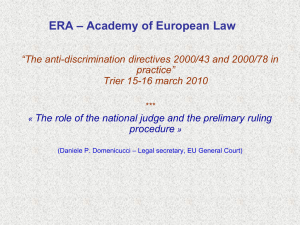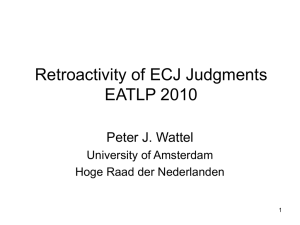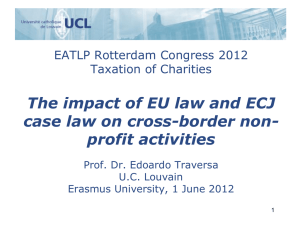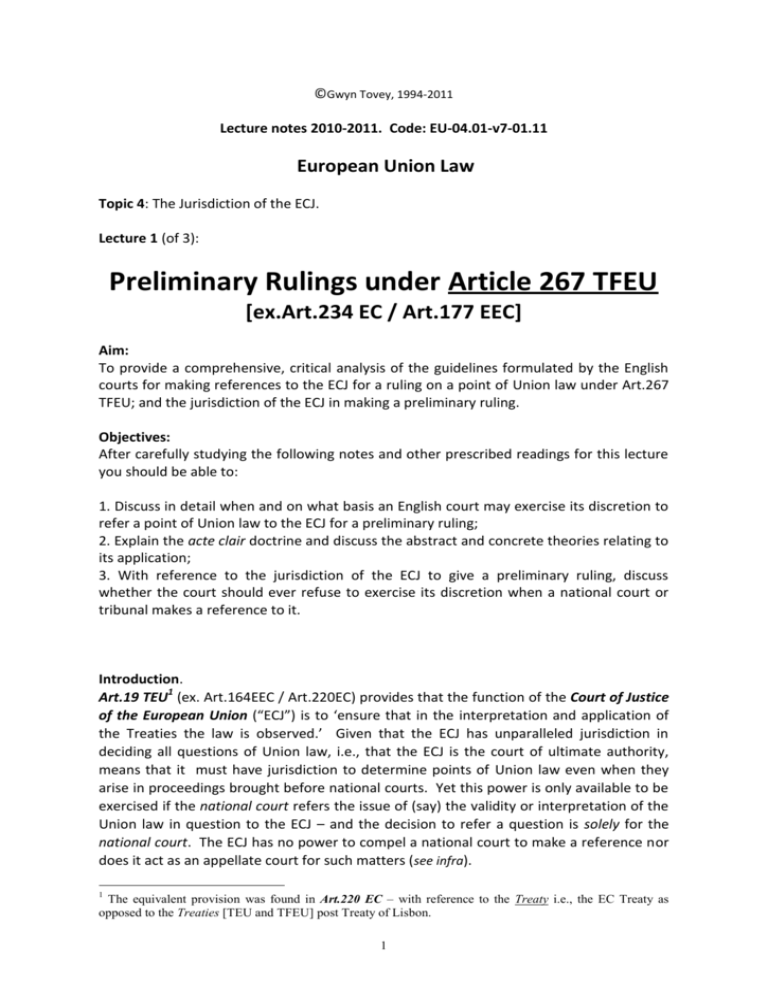
©Gwyn Tovey, 1994-2011
Lecture notes 2010-2011. Code: EU-04.01-v7-01.11
European Union Law
Topic 4: The Jurisdiction of the ECJ.
Lecture 1 (of 3):
Preliminary Rulings under Article 267 TFEU
[ex.Art.234 EC / Art.177 EEC]
Aim:
To provide a comprehensive, critical analysis of the guidelines formulated by the English
courts for making references to the ECJ for a ruling on a point of Union law under Art.267
TFEU; and the jurisdiction of the ECJ in making a preliminary ruling.
Objectives:
After carefully studying the following notes and other prescribed readings for this lecture
you should be able to:
1. Discuss in detail when and on what basis an English court may exercise its discretion to
refer a point of Union law to the ECJ for a preliminary ruling;
2. Explain the acte clair doctrine and discuss the abstract and concrete theories relating to
its application;
3. With reference to the jurisdiction of the ECJ to give a preliminary ruling, discuss
whether the court should ever refuse to exercise its discretion when a national court or
tribunal makes a reference to it.
Introduction.
Art.19 TEU1 (ex. Art.164EEC / Art.220EC) provides that the function of the Court of Justice
of the European Union (“ECJ”) is to ‘ensure that in the interpretation and application of
the Treaties the law is observed.’ Given that the ECJ has unparalleled jurisdiction in
deciding all questions of Union law, i.e., that the ECJ is the court of ultimate authority,
means that it must have jurisdiction to determine points of Union law even when they
arise in proceedings brought before national courts. Yet this power is only available to be
exercised if the national court refers the issue of (say) the validity or interpretation of the
Union law in question to the ECJ – and the decision to refer a question is solely for the
national court. The ECJ has no power to compel a national court to make a reference nor
does it act as an appellate court for such matters (see infra).
1
The equivalent provision was found in Art.220 EC – with reference to the Treaty i.e., the EC Treaty as
opposed to the Treaties [TEU and TFEU] post Treaty of Lisbon.
1
When a national court requests the ECJ to give a preliminary ruling on a matter of Union
law, as it may do under Art.267 TFEU, only the point of EC law is referred to the ECJ which,
in turn, rules on the point and remits the issue to the national court, from where the
reference was made, for a final decision. Ultimately, the national court may find that it
can dispose of the case without having to refer to the point of Union law. If it finds that it
is necessary to refer to it, however, it is bound by the ECJ’s decision: Case C-206/01,
Arsenal FC v Reed. In essence, this co-operative procedure is the mechanism by which the
Art.267 TFEU procedure functions. Indeed, as Fairhurst2 noted:
The objective of the reference procedure is to retain the independence of the
national courts, while at the same time preventing ‘a body of national case law not
in accord with the rules of [Union] law from coming into existence in any Member
State’ *Case 107/76, Hoffman La Roche v. Centrafarm].
The significance of the procedure is noted by Steiner, et al3 who say:
almost all the major principles established by the ECJ were decided in the context
of a reference to that court for a preliminary ruling under Article [267 TFEU]. ... The
procedure accounts for over 50% of all cases heard by the ECJ. [It thus] plays a
central part in the development and enforcement of [EU] law.
Since 1993, the ECJ has received more than 200 requests per year for a preliminary ruling even though it takes about 2 years for a national court to receive a judgment.4 Despite
such delays, in its report5 to the 1996 IGC, the ECJ was firmly of the view that:
The preliminary ruling system is the veritable cornerstone of the operation of the
internal market, since it plays a fundamental role in ensuring that the law
established by the Treaties retains its [Union] character with a view to
guaranteeing that the law has the same effect in all circumstances in all of the
Member States of the European Union.
The Procedure.
Article 267 TFEU provides that:
The Court of Justice of the European Union shall have jurisdiction to give preliminary
rulings concerning:
(a) the interpretation of the Treaties;
(b) the validity and interpretation of acts of the institutions, bodies, offices or
agencies of the Union
2
Fairhurst, J. Law of the European Union, 8th edn., 2010. Harlow: Pearson-Longman, p177.
Steiner, J, Woods, L & Twigg-Flesner, C. EU Law, 9th edn., 2006. Oxford: OUP, p193
4
See Fairhurst, op cit., fn.2, @p175. The time taken for a judgment to be delivered has increased from just
over 21 months (1999) to just over 2 years (2003). If the Treaty establishing a Constitution for Europe had
been ratified, Art.III-369, the provision that would have replaced Art.234EC, required, in the last paragraph,
the ECJ to act ‘with the minimum of delay’ in respect of ‘a person in custody’. That has now been added as
the last (fourth) paragraph in Art.267 TFEU.
5
‘Report of the Court of Justice on certain aspects of the application of the Treaty on European Union’,
Luxembourg, May, 1995.
3
2
Where such a question is raised before any court or tribunal of a Member State,
that court or tribunal may, if it considers that a decision on the question is
necessary to enable it to give judgement, request the Court to give a ruling
thereon.
Where any such question is raised in a case pending before a court or tribunal of a
Member State against whose decisions there is no judicial remedy under national
law, that court or tribunal shall bring the matter before the Court6.
If such a question is raised in a case pending before a court or tribunal of a Member
State with regard to a person in custody, the Court of Justice of the European Union
shall act with the minimum of delay.
Article 267 TFEU is not an appeals procedure.
It is clear from the text of Art.267 TFEU that it is not an appeals procedure. As Hartley7
notes:
There are two major differences between an appeal and a reference. First, in the
case of an appeal the initiative lies with the parties: the party who is dissatisfied
with the court’s judgment decides whether to appeal and then take the necessary
procedural steps. The court a quo normally has no further say in the matter and
cannot prevent the appeal from being lodged. Secondly, the appeal court decides
the case, even though the appeal may be on limited grounds only, and it has the
power to set aside the decision of the court a quo; normally it can then substitute
its own decision for that of the lower court. These features are not found in the
procedure for a preliminary reference: the court a quo decides whether the
reference should be made, and only specific issues are referred to the European
Court. Once it has decided these, the European Court remits the case to the
national court for a decision.
That, as a general rule, it is for the national court to decide whether a reference should be
made to the ECJ, illustrates that the ECJ’s jurisdiction depends ‘solely on the existence of a
request from the national court’: Case 338/85, Pardini’s case. It follows, then, that the
success of the Art.234 procedure is dependent on mutual cooperation between the
national courts and the ECJ. In Case 13/61, Bosch v. de Geus, A-G Lagrange said that:
Applied judiciously - one is tempted to say loyally - the provisions of Article [267
TFEU] must lead to a real and fruitful collaboration between the municipal courts
and the Court of Justice of the [European Union] with mutual regard for their
respective jurisdictions.
The ‘fruitful collaboration’ between national courts and the ECJ may be subjected to
review from the perspective of (i) the ECJ; and (ii) the national courts.
6
The changes made to Art.234 EC via the Treaty of Lisbon and enacted in Art.267 TFEU may be viewed
online at: http://en.euabc.com/upload/Reader_friendly_sept_2009-net.pdf (accessed 25th January 2010).
7
Hartley, T. The Foundations of European Community Law, 7th edn., 2010. Oxford: OUP, p287.
3
(I) Jurisdiction of the ECJ
The principal jurisdiction is in relation to paragraphs (1)(a) and (1)(b) of Art.267 TFEU.
Under both (1)(a) and (1)(b) a reference may be made with regard to the interpretation
both of the Treaty and acts of the Institutions of the Union. However, references for a
ruling on validity may be made only in the case of the latter. Notwithstanding these
express provisions, it has been claimed in the past that it is actually three issues which
may be referred for a ruling because ‘interpretation’ not only encompasses the
teleological approach to provisions adopted by the ECJ, it also extends to issues relating to
supremacy and direct effect, i.e. ‘three issues may be referred for a ruling - interpretation,
effect8 and validity’.
That issues concerning supremacy and direct effect can be referred to the ECJ for a ruling
makes it absolutely clear that that court alone has the jurisdiction to give Union law the
single, authoritative interpretation (including its effects) that applies uniformly throughout
the Member States of the EU
The phrase ‘Interpretation of the Treaties’ in Art.267(1)(a) TFEU refers to the TEU and
TFEU as may exist at any particular time. ‘Acts of the institutions,’ in Art.267(1)(b),
encompasses the binding and non-binding acts provided for in Art.288 TFEU. Whereas
Mathijsen9 contends that: “The preliminary ruling presupposes direct effect, i.e. the
possibility for an interested party to invoke Union rules in national courts and the
obligation for the national judge to uphold any rights resulting from those rules”; Steiner,
et al10 note that the ECJ “has held that an act need not be directly effective to be subject
to interpretation under Article [234]: Case 111/75 [Mazzalai].”
‘Acts of the institutions’ has also been held to encompass treaties concluded on behalf of
the EU by the Council with non-Member States: See Case 181/73, Haegemann v. Belgian
State, and Arts.218 and 352 TFEU (ex Arts.300 and 308 EC, respectively).
Purposes or Functions of Preliminary Rulings
It may be deduced from the foregoing discussion that a preliminary ruling serves at least
two functions, viz; (i) legal integration; and (ii) enhancement of individuals’ interests.
Legal integration is achieved via the preservation of the Community [now Union] character
of the law and the uniform interpretation and application - by way of general principles,
direct effects or supremacy - of EU law throughout the Member States; whereas
individuals’ who have no other remedy, or recourse only to inadequate remedies, may
8
Hartley, 4th edn., 1998, p259. It is submitted that this view must be treated with caution, however, since,
surely, the definitive interpretation of a provision will, of itself, determine what effect, if any, that provision
has: how does ‘effect’ become another, seemingly unconnected, issue? Or, how can a provision have effect
without, first, being interpreted? Hartley has offered an unconvincing explanation on p289 of the 10 th edn.
9
Mathijsen, P.S.R.F. A Guide to European Union Law, 10th edn., 2010. London: Sweet & Maxwell, p142.
10
op cit., p196.
4
seek redress against a Member State for violating their Union rights or against Union
institutions, respectively.
Confirming the first point, in Case 166/73, Reinműllen-Dűsseldorf it was stated that:
“Article 177EEC *now Art.267 TFEU+ is essential for the preservation of the
Community [now Union] character of the law established by the Treaty [now
Treaties] and has the object of ensuring that in all circumstances the law is the
same in all the States of the Community *Union+”.
Exclusion of ECJ’s Jurisdiction
That the ECJ is limited to giving preliminary rulings on matters of interpretation and
validity necessarily excludes its jurisdiction in relation to three matters, in particular, viz;
(i) matters of national law;
(ii) the application, as opposed to interpretation, of EU law;
(iii) and in deciding when a national court should make a reference.
The last point was confirmed in Case 338/85, Pardini, where it was declared that ‘it is for
the national court to decide at what stage of the procedure it is necessary for it to refer a
question to the court of justice for a preliminary ruling’. Moreover, in Pardini, the ECJ
decided it had no jurisdiction to give a ruling on a matter when the proceedings before the
national court were terminated prior to a ruling being made. Also, the ECJ will not give a
ruling if it considers that a reference has been made from proceedings in which there is an
absence of a ‘genuine’ dispute: Cases 104/79 and 244/80 Foglia v. Novello.
Case 104/79, Foglia v Novello (No.1)
Novello, in France, received wine from Foglia, an Italian wine dealer. The contract
between the parties stipulated that Novello would not be liable for any charges levied by
the French or Italian authorities which were incompatible with Union law. A tax then
levied by the French authorities formed the basis of the litigation because Novello refused
to reimburse Foglia after he (Foglia) paid it. When Foglia sued Mrs Novello before the
Italian courts she based her defences on Art.90EC [now Art.110 TFEU], on the
incompatibility of the charge with Union law. The ECJ was asked for a preliminary ruling
under Art.177EEC [now Art.267 TFEU] because the Italian court believed that Mrs.
Novello’s defence entailed calling into question the validity of French legislation
concerning the tax on wines in relation to Art.90EC [now Art.110 TFEU].
HELD: The artificial nature of the dispute was underlined by the fact that the carrier who
delivered the wine and readily paid the tax had the sum reimbursed by Foglia who ‘paid
without protest [the carrier’s+ bill which included a sum in respect of that tax’. The
judgment then proclaimed that:
The duty of the Court of Justice under Article [267 TFEU] of the [TFEU] is to supply
all courts in the [Union] with the information on the interpretation of [Union] law
which is necessary to enable them to settle genuine disputes which are brought
5
before them. A situation in which the court was obliged by the expedient of
arrangements like those described above to give rulings would jeopardise the
whole system of legal remedies available to private individuals to enable them to
protect themselves against tax provisions which are contrary to the Treaty.
This means that the questions asked by the national court, having regard to the
circumstances of this case, do not fall within the framework of the duties of the
Court of Justice under Article 267 TFEU.
The Court of Justice accordingly has no jurisdiction to give a ruling on the questions
asked by the national court.
The Italian judge who made the initial reference thought that the judgement of the ECJ
was an abandonment of its previous policy of not interfering with the decision of the
referring judge. Accordingly, he referred further questions in Foglia v. Novello (No.2).
However, the Court reiterated that:
the duty assigned to the Court by Article [267 TFEU] is not that of delivering
advisory opinions on general or hypothetical questions but of assisting in the
administration of justice in the Member States. It accordingly does not have
jurisdiction to reply to questions of interpretations which are submitted to it within
the framework of procedural devices arranged by the parties in order to induce the
Court to give its views on certain problems of [Union] law which do not correspond
to an objective requirement inherent in the resolution of a dispute.
That criminal proceedings have been instituted does not mean that the ECJ would regard a
reference from that case as being not genuine. Indeed, it has said that where ‘there is
nothing in the file on the case which provides grounds for doubting that the dispute is
genuine ... there is no reason for concluding that the Court has no jurisdiction:’ Walter Rau
v. de Smedt, Case 261/81.
When, if ever, is it permissible for the ECJ to refuse to give a preliminary
ruling?
First of all, the ECJ would not entertain a reference unless it was within the scope of
Art.267 TFEU. The refusal of the ECJ to give a ruling on a reference that has been made by
a body not recognised as a court or tribunal would be an instance where the reference
was not made within the scope of Art.267: Case 138/80, Borker. Moreover, unless the
body is a court or tribunal of a Member State the ECJ will not entertain the reference:
Case 246/80, Broekmeulen. Furthermore, as just noted, the ECJ may refuse to give a
ruling in the absence of a genuine dispute: Case 104/79, Foglia v. Novello. Likewise, the
ECJ has refused to give a ruling on questions of a hypothetical nature: C-83/91, Meilicke;
and joined cases C-320 - C-322/90, Telemarsicabruzzo; Case C-157/92, Banchero; and Case
C-386/92, Monin Automobiles. To this list must be added the situations in which
proceedings before the national court have terminated prior to the ruling being delivered:
Case 338/85, Pardini.
6
A Declaration of a Court or a Tribunal Having the Authority to Request a
Preliminary Ruling is a Matter of Union Law
Paragraphs (2) and (3) of Art.267 TFEU refer to courts and tribunals. Whether a particular
body qualifies as a court or tribunal having the authority to request a preliminary ruling is
a matter of Union law. Pollard and Ross11 have asserted that: ‘In practice, this
requirement has caused little difficulty and the court has received requests for preliminary
rulings from a wide variety of judicial bodies.’
In Case 61/65, Vaassen, in deciding that an ‘arbitration tribunal’ must be considered a
court or tribunal, the ECJ noted that persons insured under a private social security
scheme relating to the Dutch mining industry were bound to take any disputes between
themselves and their insurer to the tribunal as the proper judicial body. The tribunal was
bound by rules of adversarial procedure similar to those used by the ordinary courts of
law. By contrast, an arbitrator appointed under the terms of contract in which the parties
excluded the possibility of recourse to the ordinary courts did not come within the
definition of ‘court or tribunal’: Case 102/81, Nordsee.
Another pair of contrasting cases is provided by: Case 138/80, Jules Borker, and Case
246/80, Broekmeulen. In the former (Borker), the ECJ refused to give a ruling on case
referred to it by the Parisian equivalent of a local Bar Council on the ground that it (the
Conseil de l’Ordre des Avocats a la Cour de Paris) did not have before it a case which it was
under a legal duty to try; whereas, in the latter (Broekmeulen), an appeal committee of
the Dutch professional medical body ‘which performs its duties with the approval of the
public authorities ... operates with their assistance, and whose decisions are accepted
following contentious proceedings and are in fact recognised as final, must be deemed to
be a court of a Member State for the purpose of Article [267+:’. From a review of the early
case law, Steiner, et al12 contended that in deciding whether a body is a court or tribunal,
the ECJ laid down five criteria via which a court or tribunal might be identified, viz;
statutory origin;
permanence
inter partes procedure;
compulsory jurisdiction; and
the application of rules of law.
In essence, these were the criteria that were confirmed by the ECJ “in order to determine
whether a body making a reference is a court or tribunal for the purposes of Article [267+”,
in Case C-54/96, Dorsch Consult.
The criteria were applied in deciding that an Immigration Adjudicator could make an
Art.[234EC] reference: Case C-416/96, El-Yassini, though other case law has not placed the
same emphasis on the application of all the aforementioned criteria, i.e., the focus on any
one criterion may show that its application is not absolute: see Case C-17/00, de Coster.
11
12
Pollard, D and Ross, M. European Community Law Text and Materials. London: Butterworths, 1994.
op cit., p204.
7
(II) Do National Courts Have an Obligation or a Discretion in Deciding
to Seek a Preliminary Ruling?
Paragraphs (2) and (3) of Art.267 both refer to courts and tribunals. However, in seeking a
preliminary ruling, whereas para.(2) provides that a court of a Member State has a
discretion in that it may request a ruling, para.(3) provides that in certain cases a court or
tribunal ‘shall bring the matter before the Court of Justice.’ It seems, then, that there is a
clear distinction between discretionary references and mandatory references.
Discretionary Jurisdiction of National Courts.
Courts or tribunals not within the ambit of Art.267(3) have an unfettered discretion in
deciding to seek a preliminary ruling. To emphasise this point: it is for the national courts
to decide whether or not to make a reference; to decide the legal issue(s) for reference;
and to decide at what stage in the proceedings to make the reference. That an appeal is
pending before an English appellate court is no bar to making a reference: neither is a
national court precluded from making a reference when the ECJ has ruled on a similar
question from another court: Cases 28-30/62; nor is the discretion to refer fettered by
national rules of precedent: Cases 146/73 and 166/73.
Two important aspects of a national court’s exercise of its discretion are when should it be
exercised and on what basis it should be exercised.
(i) When the discretion should be exercised.
With regards as to when to exercise discretion, a national court should make a reference
only when it is necessary for it to give a judgment. In Bulmer v. Bollinger (1974), Lord
Denning suggested that a reference was ‘necessary’ only if it was ‘conclusive’ to the
judgment. A reference would not be considered necessary if the ECJ had (i) already ruled
on the question in issue; or (ii) the matter was reasonably clear and free from doubt.
(ii) The Basis on which the Discretion should be exercised.
The general rule, subject to exceptions in urgent matters, is that the facts of the case
should be decided before a reference is made: Bulmer v. Bollinger (1974); R v. Henn (H.L.
1978); and Irish Creamery Milk Supplies Association v. Ireland, Cases 36 & 71/80.
Indeed, in Bulmer v Bollinger guidelines provided by Lord Denning suggested that the
following facts should be taken into account:
(a) the facts should be decided first, so the question of whether it was ‘necessary’ could be
settled;
(b) the costs of the parties;
(c) the difficulty or importance of the question;
(d) the wishes of the parties could be considered, although it was for the courts to decide
whether to make a reference; and
(e) the need to avoid overloading the ECJ.
8
Lord Denning’s guidelines have been followed and clarified in R v.H.M. Treasury, ex parte
Daily Mail & General Trust PLC (1987); and in R v. Pharmaceutical Society of G.B., ex parte
the Association of Pharmaceutical Importers (1987). However, following a more recent
Court of Appeal case, R v. International Stock Exchange of the U.K. and the Republic of
Ireland, ex parte Else (1993) there now appears to be a presumption in favour of a referral
to the ECJ on points of [Union] law. To quote O’Neill and Coppel13:
The Court of Appeal, in the Stock Exchange case, stated that where a court has [1]
found the facts of a case and considers that the Community law issue is [2] critical
to its final decision, it should ordinarily make a reference, unless [3] it can with
complete confidence resolve the issue itself. Such confidence can only be justified
after a full consideration of the difference between national and [Union]
legislation, of the pitfalls of venturing into a potentially unfamiliar field, of the need
for uniform interpretation of the law throughout the [Un ion] and of the expertise
and logistical advantages enjoyed by the Court of Justice.
The Court of Appeal’s approach approximates to that of the Court of Justice, which
has also stressed the need for uniformity of [Union] law and the difficulties which
national judges face in deciding questions of [Union] law for themselves.
Thus, the approach now likely to be taken by courts having a discretion to refer
approximates to that taken by the ECJ in Case 283/81, CILFIT, a case which concerned the
obligation to refer of courts ‘against whose decisions there is no judicial remedy,’ i.e.
courts of final resort. (This case and an analysis of what is meant by courts of final resort
are considered on p9 of these notes).
The other factors referred to by Lord Denning in Bulmer v. Bollinger have been subject to
some academic and judicial comment, though they remain virtually unmodified, e.g.: in
terms of time and cost it may be appropriate to make a reference at the earliest stage in
proceedings. A reference can be made by a magistrates’ court - and it may be appropriate
to do so - even though its order for a reference may be quashed on appeal: R v. Plymouth
Justices, ex parte Rogers (1982).
In terms of the wishes of the parties, ‘... it is the right of the plaintiff to go to the European
Court’ per Templeman LJ in Polydor v. Harlequin Record Shops (1980).
‘Mandatory’ References
The House of Lords clearly is a court ‘against whose decisions there is no judicial remedy
under *English+ law.’ Accordingly, Lord Denning in Bulmer v. Bollinger was in no doubt that
‘... short of the House of Lords, no other English court is bound to refer a question to the
*ECJ+.’ However, it does not follow that only the highest court in any Member State is a
court ‘against whose decisions there is no judicial remedy ...’ In Case 6/64, Costa v. ENEL,
13
O’Neil, A and Coppel, J. EC Law For U.K. Lawyers. London: Butterworths, 1994.
9
the defendant had no right of appeal in a case where the sum of money in question was
very small (equivalent of approximately £1-10p). On a reference from the Italian
magistrates’ court, a referring to Art.234(3) the ECJ said:
By the terms of this Article ... national courts against whose decisions, as in the
present case, there is no judicial remedy, must refer the matter to the [ECJ].
The result is that the scope of Art.267(3) is unclear. In short, a so called ‘abstract theory’
applies to courts whose decisions are never subject to appeal while a so-called ‘concrete
theory’ provides that Art.267(3) applies to the highest court in a particular case. The
wording of the paragraph favours the abstract theory. In contrast, Costa v. ENEL indicates
that the ECJ has favoured the concrete theory.14
Acte Clair and the ‘Obligation’ to Make a Reference.
The third paragraph of Art.267EC provides that:
Where any such question is raised in a case pending before a court or tribunal of a
Member State, against whose decisions there is no judicial remedy under national
law, that court or tribunal shall bring the matter before the Court.
This seemingly indicates that a reference must be made by a national court, i.e., there is
no discretion when:
There is no judicial remedy under national law; and
Where any such question is raised [relating to the interpretation of the Treaty and /
or the interpretation or validity of an act of an Institution of the Union]; and
A decision on the question is necessary to enable the national court to give
judgment.
Accordingly, in theory, anyway, if a top national court breached Art.267(3) by failing to
refer a question to the ECJ, it could render the state in which it is situated liable in
damages to an individual who has been thereby deprived of his / her Union rights: Case C224/01, Kobler v Austria.
Yet, despite the wording in Art.267(3) the ECJ in held in Case 283/81, CILFIT that:
courts or tribunals referred to in [Article 267(3)] have the same discretion as any
other national court or tribunal to ascertain whether a decision on a question of
[Union] law is necessary to enable them to give judgement.
The court went on to conclude that a national court would not have to seek a preliminary
ruling when:
14
See Steiner, Woods & Twigg-Flesner, pp207-209 for further discussion.
10
(a) the question [of EC law] is irrelevant; or
(b) the Union provision in question has already been interpreted by the [ECJ]; or
(c) that the correct application of Union law is so obvious as to leave no scope for any
reasonable doubt. The existence of such a possibility must be assessed in the light of the
specific characteristics of Union law, the particular difficulties to which its interpretation
gives rise and the risk of divergences in judicial decisions within the Union.
There is considerable similarity between criteria (b) & (c) in CILFIT and (i) & (ii) of Bulmer v.
Bollinger (supra). They amount to acte clair. In essence, this means that if the meaning of
a provision is clear, not open to ambiguity, then no question of interpretation arises. No
requirement for interpretation equates with no requirement for a reference. Whilst it
sounds very simple, Lord Widgery’s idea of what was clear in R v. Henn (1978) proved to
be incorrect when a reference was made to the ECJ! In CILFIT, ‘so obvious as to leave no
scope for any reasonable doubt’ meant that the national court must be convinced that
‘the matter is equally obvious to the courts of the other Member States and to the Court
of Justice’ (para. 16).
The national courts would have a sound basis for their conviction if, in relation to the case
in point, there was a ‘considerable and consistent line of case law’ already decided by the
ECJ, per Lord Diplock in Garland v. British Rail Engineering Ltd. (1983). Thus, a version of
acte clair approved in CILFIT has been adopted by the House of Lords.
Moreover, O’Neil and Coppel15 assert that:
Following the Stock Exchange case, a decision to refer will be overturned where the
higher court comes to the conclusion that the referring court could indeed have
decided the question of [Union] law with complete confidence.
Equally, if a national court did not refer a question because, mistakenly, though acting
in good faith, it believed that the CILFIT criteria were satisfied, the State would not be
liable in damages: Case C-224/01, Kobler v Austria (supra).
‘Precedent’ and the Art.267 TFEU Preliminary ruling Procedure
In essence, then, Case 238/81, CILFIT, also decided that there may be no breach of
Art.4(3) TEU (ex.Art.10 EC) if a national court does not refer a point of EU law to the ECJ
under Art.267 TFEU, because where the facts of the case are very similar to those of a
decided case then:
The authority of an interpretation under Art.[267 TFEU] already given by the [ECJ]
may deprive the obligation of its purpose and thus empty it of its substance. Such
is the case when the question raised is materially identical with a question which
has already been the subject of a preliminary ruling in a similar case.
15
op cit., p71
11
Indeed, neither CILFIT nor academic opinion were ‘new’ in respect of alluding to
precedent: more than forty years ago, indeed just after Case 26/62, van Gend en Loos was
decided, the ECJ pronounced in Cases 28-30/62, Da Costa, that:
The questions of interpretation posed in this case are identical with those settled in
[Case 26/62, van Gend en Loos] and no new factor has been presented to the
Court. In these circumstances the [national court] must be referred to the previous
judgment
There is no doubt, then, theory aside, Da Costa did initiate a system of precedent – a
system that helps underpin the general principle of legal certainty; and a principle that has
been further elaborated in cases such as Case 238/81, CILFIT. Moreover, the willing
adherence to follow previous decisions was notable in Case 338/85, Pardini, where the ECJ
upheld its previous judgments by expressing it thus:
As the court has consistently held, Article [267 TFEU] establishes a framework for
close cooperation between the national courts and the Court of Justice based on
the assignment to each of different functions.
Reforms of the Art.267 TFEU Procedure as from July 2000 to Date
In July 2000 a simplified procedure was introduced. This permitted references that are
virtually identical to questions that have been answered previously to be provided via
reference to its previous judgment or the relevant case law. In essence, the procedure is
appropriate where the answer to the current question can be deduced from decided case
law and the current question raises no issue that would create reasonable doubt as to the
answer.
Since the coming into force of the Treaty of Nice (1 st Feb. 2003) Preliminary Rulings
jurisdiction is no longer within the exclusive competence of the ECJ. Art.256 TFEU
(ex.Art.225(3)EC) provides the authoritative basis for according the General Court
jurisdiction to give rulings in specific instances as laid down by the Statute of the Court of
Justice. However, (i) the General Court can refer a case to the ECJ if it (the General Court)
believes that the case will affect the unity or consistency of EU law; or (ii) the ECJ has the
power (as provided by its statute) to review a preliminary ruling given by the General
Court if there is a serious risk that the unity or consistency of EU law will be affected.
Finally there is now an urgent preliminary ruling procedure – which has enabled some
rulings to be given after just a couple of months – and these relate to questions on the
area of freedom, security and justice. The procedure was used for the first time in 2008 in
Case C-195/08, PPU.
………………………………………………………………………………..
12
References
Brown, L.N and Kennedy, T. The Court of Justice of the European Communities, 5th edn.,
2000. London: Sweet & Maxwell, Ch.10;
Chalmers, D, et al. European Union Law Text and Materials. Cambridge: CUP, 2010, Ch.4,
especially pp149-178;
Craig, P & De Burca, G. EU Law: Text, Cases & Materials, 4th edn., 2008. Oxford: OUP,
Ch.13;
Craig, P & De Burca, G (eds). The Evolution of EU Law. Oxford: OUP, 1999, Ch.6;
Fairhurst, J. Law of the European Union, 8th edn., 2010.. Harlow: Pearson Longman, 2006,
Ch.6;
Foster, N. EU Law Directions, 2nd edn., 2010. Oxford: OUP, Ch.6;
Hartley, T.C. The Foundations of European Union Law, 7th edn., 2010. Oxford: OUP, Ch.9;
Kaczorowska, A. European Union Law, 2nd edn., 2010. Abingdon: Routledge, Ch.10;
Steiner, J, Woods, L, & Twigg-Flesner, C. EU Law, 9/e. Oxford: OUP, 2006, Ch.9;
Weatherill, S. Cases & Materials on EU Law, 9th edn., 2010. Oxford: OUP, Ch.7
………………………………………………………………………………………………...
Workshop Questions.
1. “The construction of a constitutional, rule of [EU] law has been a participatory process,
a set of constitutional dialogues between supranational and national judges”.
[From Stone Sweet, A, ‘Constitutional Dialogues in the European Community’ in The European
Courts and National Courts. Doctrine and Jurisprudence, ed Slaughter, A.M et al. Oxford: Hart
Publishing, 1998]
In securing preliminary rulings under the Art.267 TFEU procedure, to what extent has this
‘participatory process … between supranational and national judges’ proved to be a
‘fruitful collaboration’?
2. “The *EU] treat[ies] make the jurisdiction of [the ECJ] dependent solely on the existence
of a request [from a national court] for a preliminary ruling within the meaning of Article
[267 TFEU]. And it does so without requiring [the ECJ] to discover whether the decision of
the national judge has acquired the force of res judicata under the national law”.
[Quotation updated and modified from the original in Case 13/61, Bosch]
With reference to this extract, explain the role of national courts in referring to the ECJ
questions for preliminary rulings under the Art.267 TFEU procedure.
13
3. “The preliminary ruling system is the veritable cornerstone of the operation of the
internal market, since it plays a fundamental role in ensuring that the law established by
the Treaties retains its [Union] character with a view to guaranteeing that the law has the
same effect in all circumstances in all of the Member States of the European Union”.
[Extracted and updated from: ‘Report of the Court of Justice on certain aspects of the
application of the Treaty on European Union’, Luxembourg, May, 1995+.
Discuss.
4. Critically evaluate the assertion that it is difficult to defend any of the grounds on which
the opportunity for a reference to the ECJ for a preliminary ruling under Article 267 TFEU
may be avoided by a court of a Member State.
14

